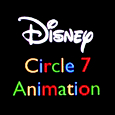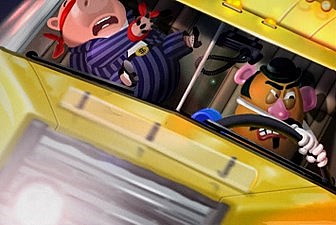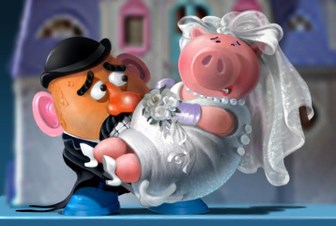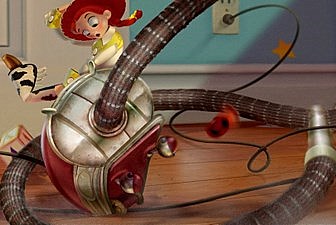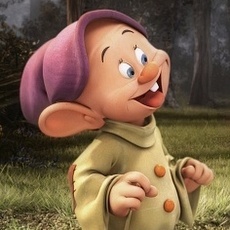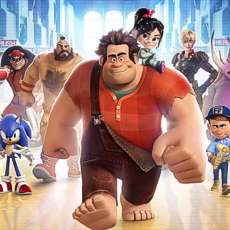At first glance, the filmography of screenwriting partners Bob Hilgenberg and Rob Muir may seem deceptively brief. But many of their most intriguing projects are ones for which they have gone uncredited, some of which never even entered production.
Hilgenberg and Muir met while writing and performing at The Second City, LA. From there and The Groundlings, they transitioned to television. One of their first jobs was writing for cable network USA’s Up All Night, in which hosts introduced movies late at night on weekends. After a couple of other gigs, the duo, who had adopted the collective pseudonym Bob & Rob, moved from television series to a movie inspired by a television series, penning the unproduced screenplay for Love Boat (1998).
In 2003, Bob & Rob wrote and directed the short film Hiding in Walls, starring Jane Lynch and Danny Trejo. Satirizing their career, Walls told of two screenwriters who impress in an unprepared pitch meeting only to then face a massive case of writer’s block.
Pleased with their short, Bob & Rob had no idea of the direction their life was about to take – or the excitement, drama and sadness they were about to experience.
All they knew was that when Disney offered for them to write Toy Story 3, they said yes.
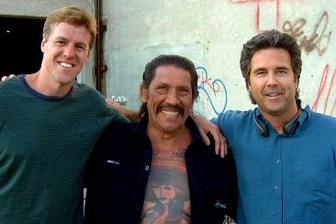
Rob Muir and Bob Hilgenberg with actor Danny Trejo (middle)
New to the animation community, Bob & Rob were unaware of the events leading up to that moment. In November 1995, Walt Disney Pictures released Pixar Animation Studios’ first full-length feature, Toy Story, to critical acclaim and a box office total of more than $360 million. Proud of its initial collaboration, Disney signed Pixar to a five-picture deal, soon commissioning Pixar to make Toy Story 2, planning the sequel as a direct-to-video release. But when Disney execs saw early footage, they were convinced to release Toy Story 2 in theaters.
Believing it did not meet theatrical standards, Pixar reworked the sequel’s story and completed the entire film in an exhausting nine months. The hard work paid off in that Toy Story 2 (1999) grossed $485 million and was widely hailed as one of the rare sequels to be better than its predecessor. However, then Disney Chairman and CEO Michael Eisner dropped a bombshell on Pixar CEO Steve Jobs and creative head John Lasseter: Disney did not count Toy Story 2 as one of the pictures in the five-picture deal, since the agreement encompassed only original features, not sequels.
From that point, tensions grew between Disney and Pixar, the latter studio striving to maintain excellence, unveiling celebrated hits such as Monsters, Inc. (2001) and Finding Nemo (2003). Disney, however, was consistently churning out criticized direct-to-video sequels to its animated classics, via its DisneyToon Studios animation house. Finally, the time came for Disney to renegotiate a deal with Pixar – only the deal did not happen.
In January 2004, Jobs announced that Pixar would not renew its relationship with Disney, shaking the animation industry as it watched one of the most successful partnerships in entertainment history come to an end. According to Jobs, the terms of the distribution deal were titled too heavily in Disney’s favor. In exchange for distributing its films, Pixar would have been forced to split profits with Disney and also pay a distribution fee of 10 to 15 percent of revenue. Jobs argued that Pixar should keep the profits for itself in addition to cutting Disney’s fees.
Art Director Ric Sluiter’s concept artwork for Circle 7’s Toy Story 3
(Click to enlarge)
Eisner responded that Disney did not need Pixar. Instead, he believed the studio could make computer animated films mimicking Pixar’s style, to where the audience would not even know the difference. Supporting this idea, Eisner revealed Disney would begin production on multiple sequels to titles in its Pixar library, since the five-picture contract stated Disney owned any characters in those films.
But Disney shareholders were furious that Eisner would allow Pixar to leave, given the animation powerhouse’s track record. In March 2004, at Disney’s annual shareholder meeting, 43 percent of Disney’s shareholders withheld their proxies to re-elect Eisner to the board of directors. One year later, Eisner announced he would step down as CEO one year before his contract expired – a promise he fulfilled that September.
In 2005, Disney launched Circle 7 Animation, named after the Glendale street where it was located. The sole purpose of Circle 7 was to create one sequel a year, each with a budget below $100 million, to Disney-owned Pixar films. The unit was led by Andrew Millstein, who had previously headed the Florida-based Feature Animation studio Disney closed in 2004.
Just as Pixar began with Toy Story, so would Circle 7. It scheduled Toy Story 3 to be released in spring 2008. Lion King 1 1/2 director Bradley Raymond signed to helm the sequel, while Treasure Planet producer Roy Conli agreed to produce. Artists Ric Sluiter and Shane Zalvin were two key players in the film’s visual development.
More than 40 screenwriters had been pitching ideas for sequels to Disney’s post-Pixar animation slate. At least six of those writers contributed ideas for Toy Story 3 – including Bob & Rob, although Disney chose to go in a different direction than what they had pitched. Ideas for the film varied. Teacher’s Pet husband-and-wife screenwriters Bill and Cheri Steinkellner presented a draft in which Woody, Buzz and the gang had to solve a whodunnit mystery of toys disappearing in the attic of Andy’s grandmother. Jim Herzfeld then submitted a draft in which Woody and his plastic comrades ventured to save Buzz after the spacetoy was sent to Taiwan due to a product recall.
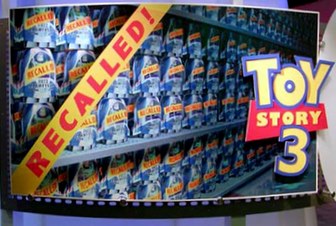
Using a screen capture from Toy Story 2, Disney premiered this Circle 7 promotion at Siggraph 2005.
Remembering the duo’s Toy Story 3 pitch, Disney asked Bob & Rob to come aboard the Monsters, Inc. sequel. As a result, the duo wrote what Hollywood insiders suggest was one of the best unproduced screenplays at Disney. Subtitled Lost in Scaradise, the sequel followed monsters James P. Sullivan and Mike Wazowski as they left Monstropolis to find little girl Boo in the human world. Scaradise impressed Disney execs enough that they assigned Bob & Rob to rewrite Toy Story 3.
But while great strides were being made at Circle 7, new Disney CEO Robert Iger knew the company could not afford to lose Pixar. He also knew Disney could not have both Pixar and a separate studio making sequels to Pixar’s films. In January 2006, Disney announced the $7.4 billion purchase of Pixar. In March 2006, it announced the closing of Circle 7.
Of the 168 Circle 7 employees, 136 were absorbed into Walt Disney Animation Studios, where they worked on Meet the Robinsons (2007), Bolt (2008) and Tangled (2010). In September 2008, Millstein became the general manager of Walt Disney Animation Studios, reporting to Disney and Pixar animation Chief Creative Officer Lasseter and President Ed Catmull. Raymond moved to DisneyToon Studios, where he helped launch the successful Tinker Bell direct-to-video franchise.
Pixar went on to create their own Toy Story 3, helmed by Toy Story 2 co-director Lee Unkrich and written by Oscar-winning Little Miss Sunshine screenwriter Michael Arndt. Toy Story 3 received an Oscar nomination for Best Picture and grossed one billion dollars worldwide. Pixar is currently developing Monsters University, a prequel revealing the college years of Mike and Sully.
As for Bob & Rob, they collaborated with Raymond to write Tinker Bell and the Great Fairy Rescue, while also lending input to other DisneyToon titles. At Walt Disney Studios, they recently sold a pitch for a live-action Molly Shannon vehicle about the social world of motherhood. Meanwhile, Bob & Rob are hard at work on a live-action adaptation of the late Bil Keane’s Family Circus comic, for Fox and Walden Media.

Tinker Bell, Rob Muir, Bob Hilgenberg and Vidia at the Tinker Bell and the Great Fairy Rescue premiere
Despite their full lineup, Bob & Rob graciously agreed to one more project: an exclusive interview (via email exchanges, to accommodate their schedules) detailing the rise and fall of Circle 7 Animation…
Animated Views: Before we get to Circle 7, could you describe your experience writing and performing with The Groundlings and The Second City, LA?
Bob Hilgenberg & Rob Muir: It combined improv with sketch comedy. Typically you would discover a funny or interesting character during an improv show and then go away and write up a sketch for that character. Eventually, you would show it to the company and the company director, and see if it was as funny as you thought it was. If it worked, you’d polish up the sketch, and it would go into the show!
AV: How did you become writing partners? After all, a lot of writers prefer to work alone. What was it about each other that made you think, “I want to work with this guy for a long, long time.”
BH & RM: We were performing in the same comedy group, and we simply transitioned from writing comedy sketches together to writing some TV specs. Comedy sketch shows don’t pay anything; they’re used more for showcasing talent. But, writing professionally does pay, obviously, so we figured why not give it a shot. We had similar sensibilities, and we just started working on stuff.
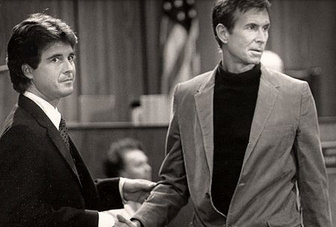
Under the screen name Robert Destri, Bob Hilgenberg played the
character Public Defender alongside Anthony Perkins in Psycho II.
Then we had a friend, Rhonda Sheer, who had a TV show on USA, and she asked us if we wanted to write some “bumpers” for her show. It didn’t pay a lot, but we worked for her for about six months and eventually got enough traction to get an agent! We signed with the TV department. Then one of the agents in the feature department read some of our samples and thought we could write features. We wrote a spec script for him, and he set up a meeting based on that material. Once in front of producers and studios, we started pitching our ideas. Eventually we sold a pitch to Paramount called Small World – no connection to Disneyland’s ride. Once we were in the “club,” it was our job not to get thrown out! We’ve been working steadily ever since.
AV: So you turned to writing instead of performing. Any particular reason?
BH & RM: A couple of reasons. Like we said, The Groundlings and Second City promoted writing, much like SNL sketches, and you learn things like how to get in and out of scenes quickly. If you’re performing, you can sense from the audience when something is or isn’t working. (If they’re laughing, it’s funny; if they aren’t, it’s not.) It gave us good instincts that we use to this day. The trick now is to do it without an audience, just your writing partner.
AV: Bob, you wrote for a series which always intrigued me as a boy: The Munsters Today. How did you land that gig?
BH: Ha! What an odd show that was. But, I was happy to get the gig. A good friend of mine was writing on the show and asked to do an episode with him. His name is Billy Riback, and he went on to be a very successful writer on Home Improvement. Billy is also a stand-up comedian and has one of the fastest, most brilliant comedy minds in the business. He writes for a ton of the Disney Channel shows now.

AV: You guys have updated a couple of other classic TV series. For instance, The Love Boat.
BH & RM: Actually, Love Boat was a feature script that was never produced. It was back when they were doing “send-ups” of all of the old TV classics, like The Brady Bunch. New Line Cinema had the property along with Aaron Spelling. We wrote what was, at the time, considered a very funny script – a total goof on the original show.
But, Mr. Spelling had final script approval and was mortified that we would disrespect his beloved TV characters. The studio brought in a director and tried to get him to come aboard – pun intended – but it never happened. At one point, they had us write a part for Howard Stern, where he has a crazy bizarro-world-type boat that tried to pirate the Love Boat. Broad? Yes. Funny? Very!
AV: You also wrote a big screen adaptation of Father Knows Best, which was set to star Tim Allen. What happened to that project?
BH & RM: The studio execs changed, and the project was put on hold. [We] believe it has been put back into development.
AV: How did you get a production office at Disney?
BH & RM: We’ve been here off and on for 13 years. The first stint here at the old Animation Building was when we were working on a couple of projects: Poker Night with Emilio Estevez’s company, and a MOW [Movie of the Week] called Secret Agent Dad for producers Laurence Mark and John Baldecchi. They were working with writer-director Stephen Sommers, who had a big office in their wing. Steve was off shooting a film for a long time, so they loaned us his office. When he came back, we got an office of our own to work on the projects.
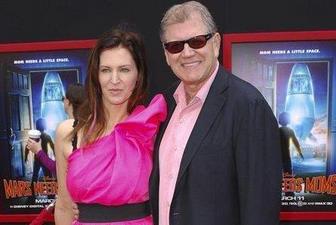
Director Robert Zemeckis with wife Leslie at the Los Angeles
premiere of Mars Needs Moms at the El Capitan Theatre
We kept selling pitches and stayed at Disney for about five years. Then we sold a TV pilot to Sony, so we moved to their studio. We came back and worked for Robert Zemeckis on a draft of Mars Needs Moms that he “threw in the trash” after reading 25 pages. We were surprised because his development staff was in love with the draft. But, we were told he didn’t like stories that followed two story lines, like Finding Nemo, and this is what we tried in that draft. If you look at some of his classic films, he does follow that rule of staying with his protagonist all the way through his stories. Most of the time he’s right!
AV: Was director Simon Wells already involved with Mars Needs Moms?
BH & RM: No. Wells came on after Zemeckis tossed our draft. We did get some notes from Zemeckis before he hired Wells. The notes had to do with turning Mars into a planet that resembled “Nazi Germany” with “Storm Trooper-type martians” ruling the planet. We never responded to his suggestions because they decided we were just too far off conceptionally from Zemeckis, and it would be best to start from scratch with a new writer. Months later, they hired Wells and his wife.
AV: So let’s talk about Disney’s Circle 7. I’d like to start at the very beginning. How did your relationship with Circle 7 begin?
BH & RM: A year before Circle 7 was created, we had been sent some material and asked to come up with a “take” for Toy Story 3 from a new division forming that wasn’t Pixar, obviously, but was a division of Disney. They wanted ideas for the Toy Story 3 feature. We met with Andrew Millstein, who was working with that division – commuting from Florida, we believe – at the time. We came up with an idea that was rejected and wasn’t close to what the ultimate Circle 7 version would become. They went with a draft from an idea from someone else, whose idea they liked more, obviously. That is all we can remember.
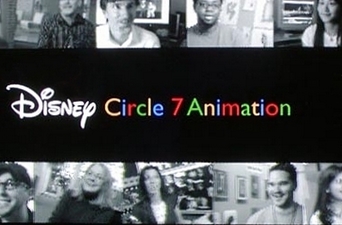
Disney’s Circle 7 recruitment image at Siggraph 2005
Flash forward a year or so later, and we were asked to meet with Disney at Circle 7. Happily, our old friend Andrew Millstein remembered us and that he had liked us from that earlier meeting(s) about Toy Story 3. Keep in mind we weren’t involved with animation at all in those days; we had no idea what Disney and Pixar were going through. We thought it was all part of one big, happy family. That, of course, changed once we started working at Circle 7. We slowly put the pieces together; we saw that we were on a very slippery slope and prayed our hard work wouldn’t be for nothing – except the money, of course.
They were already well into Toy Story 3 by now and had Jim Herzfeld working on a draft, off of an earlier draft from – as we recall – someone who was an assistant at Disney who came up with the original concept. We met with Andrew and producer Allison Segan. They gave us a choice of coming up with sequel ideas for one of two films: Finding Nemo or Monsters, Inc. We immediately gravitated to Monsters, Inc., because of our comedic style with Mike and Sully bantering, etc.
We went away for a few weeks and came back to pitch. It went as well as any pitch meeting we’d ever had. We learned later that we were the first writers to pitch a Monsters, Inc. 2 idea. It took a month for them to hear all of the 30 or more pitches, but eventually they called us back. Andrew told us that they knew we were the guys for the job, and they had flipped over our story, but they needed to hear all of the “takes.” It was a great day. To this day, Andrew Millstein has remained a good friend and has always been great to us.
The last step in getting the Monsters, Inc. 2 job was meeting and pitching to Michael Eisner. He hadn’t been involved in “creative” for a while, but Circle 7 was obviously very important to him. He was wearing a sweater and slacks. We found him to be an amazingly open, nice, self-deprecating guy.

Concept artwork for Circle 7’s Monsters, Inc. 2: Lost in Scaradise
We scared the producers to death when at the start of the meeting, at a conference room in his office at Team Disney, we stood up and threw our Annual Passes for Disneyland on the table! We said, “Look, we’ve been pass holders for years. And now that we have your attention, we’d like you to answer an important question.” The room of execs and our producers were dying. Then we asked him why the Pirates of the Caribbean ride didn’t have Fastpass! He didn’t flinch and proceeded to tell us exactly why! It has something to do with the fact that the ride moves faster without Fastpasses. It was a detailed answer that showed us he really was a hands-on guy. It was also a great ice-breaker.
We went on to pitch Monsters, Inc. 2, and he loved it! We had a great meeting. When one of us had to use the restroom, he said, “Just use my personal one right there – and look at the walls. I’ve wallpapered it with newspaper articles of all of my bad press clippings!” It was! We later learned that our pitch was Eisner’s last script meeting of any kind at Disney. He was fired weeks later.
AV: Since your initial Toy Story 3 idea was rejected, how did you become the film’s screenwriters?
BH & RM: We had written about half of Monsters, Inc. 2. The studio absolutely flipped over it. We all knew we had something really special. At the same time, they had gotten the draft of Toy Story 3 and were in a jam to get a rewrite completed to meet their production deadlines. Because they were so happy with our work on Monsters, Inc. 2, they asked us to stop writing Monsters, Inc. 2 and switch to Toy Story 3!
Art Director Ric Sluiter’s concept artwork from the opening “playtime” scene of Circle 7’s Toy Story 3
(Click to enlarge)
We had about three or four weeks to do a really significant rewrite. Suddenly, we had left Mike and Sully and were thrust into the world of Buzz and Woody and the gang! It was a very exiting time. They were in a time crunch, but they let us go alone and go through our usual writing process. When we finished, we remember showing up to the studio the following day. As we walked toward our office, we were stopped by the director, Brad Raymond, who literally hugged us! We knew we were going to be working for Disney for a long time at that point. Long story short, we launched into polishing Toy Story 3 and then dropped back into Monsters, Inc. 2, occasionally being asked to view story reels and polish up the script that was in full story production at this point.
So, to be clear, we only wrote on one Toy Story 3 script: the Circle 7 version. We were the last writers on the script, and we finished the draft at the end of 2005. Then we went back to work on finishing Monsters, Inc. 2.
It was kind of crazy writing Monsters, Inc. 2, then shifting to Toy Story 3, and back. When we handed in Monsters, Inc. 2, we were exhausted but thrilled with the reaction to the draft. It was at this time that the realities of what was happening with Disney and Pixar began to seep into our minds more and more. Everyone at Circle 7 was nervous, but we still had a job to do, and we all took these sequels very seriously. Nobody wanted to do anything but pay homage to these classic animated films. We have never worked with a more talented and professional group since.
AV: [Former Disney Chairman] Dick Cook called the Monsters, Inc. 2 screenplay one of the best he had ever read. How did his feedback come about?
BH & RM: As crazy as it seems now… After Eisner left, Bob Iger and Dick Cook wanted to be involved in the writing of the films. They were really hands-on guys, and we respected that and welcomed their notes. We met twice with them at Circle 7. Both times, they had read the drafts at whatever point we were at, and then we would pitch them the rest of the story.

Concept artwork for Circle 7’s Monsters, Inc. 2: Lost in Scaradise
It’s pretty surreal having Bob Iger give you a script note. It was a joke, and he actually made it better! Very nice men. Eventually, everyone would read the drafts. We heard that they loved the scripts, but never met with them after the buyout.
AV: Does it bother you that your Monster, Inc. 2 idea, despite all the praise, wasn’t used? Some folks think your idea sounded better – and more necessary – than the prequel Pixar is doing.
BH & RM: Well, it’s been a number of years now, so a lot of the sting of Circle 7 and the buyout has gone away. If we knew it wasn’t going to be used when we first wrote it, and our blood was still on the pages, then yes, it would’ve sucked. But, now it’s just one of the many chapters of our lives as screenwriters. That said, just purely as fans, we’d like to see our draft produced.
AV: Can we review the timeline of Circle 7’s Toy Story 3 screenplay even when you weren’t involved? There is a lot of confusion among fans. I know Jim Herzfeld wrote a Toy Story 3 screenplay. Cheri Steinkellner and Bill Steinkellner also wrote a Toy Story 3 screenplay, with revisions by David Guion and Michael Handelman. Rumor has it that the latter screenplay, involving Andy’s grandmother, was later in consideration to be Toy Story 4.
BH & RM: All we know is that any writers you reference before Jim Herzfeld were different projects. Maybe the earlier ones that were at the time of our original meeting with Disney, pre-Circle 7.
AV: Since you wrote Toy Story 3, were you going to work on Toy Story 4, too?
BH & RM: They had started negotiations with our agent for that, yes.
Art Director Ric Sluiter’s concept artwork for Circle 7’s Toy Story 3
(Click to enlarge)
AV: I’ve read Disney has been hearing pitches for Toy Story 4 in recent months. Have you presented a pitch for Pixar’s Toy Story 4?
BH & RM: No. I’m not sure the powers that be even know who we are – at least, not how connected we were to the Toy Story world. We would love to be involved. It’s always felt like an unfinished painting.
AV: What was your idea for Toy Story 4?
BH & RM: I think we were too busy writing Monsters, Inc. 2 and noodling with Toy Story 3 to have even entertained an idea for Toy Story 4. We just knew they were so pleased with our work, that they wanted to lock us up for Toy Story 4.
AV: Do you know if Lasseter read your screenplays? There are some striking similarities between your Toy Story 3 and Pixar’s Toy Story 3.
BH & RM: That’s a tough one. We actually have no way of knowing. Our honest feeling is no, he did not personally read it. If you knew John Lasseter, and we do – Bob actually went to high school with him – you’d know it isn’t in his character.
But, yes, of course, it’s kind of silly to think that someone involved – or ultimately involved – with Pixar didn’t read the draft. It may have been as innocent as someone simply not remembering that they read or heard about the script. The opening sequence is almost identical to our version, just put in the Old West.
But look, as full-time screenwriters, there are tons of ideas floating around our heads all the time, and we can’t recall where they came from. Did we just come up with it, or did we read it, dream it or hear it at a party? That’s why we ask people, for their own protection, don’t pitch us anything. In three years, we may have a great idea – but it’s yours, and we wouldn’t recall!
Art Director Ric Sluiter’s concept artwork from the opening “playtime” scene of Circle 7’s Toy Story 3
(Click to enlarge)
AV: Did you write any other sequels for Circle 7?
BH & RM: Ha! No. Two crushing disappointments is enough for one career.
AV: Animation enthusiasts and Pixar loyalists weren’t entirely receptive to Circle 7. Some even gave it the nickname “Pixaren’t.” How did that affect the mindset and motivation of Circle 7’s employees?
BH & RM: All I can say is that everyone looked at this as an opportunity to be as good, if not better, than the originals. This came from our reverence and respect for the original films and Pixar in general. We didn’t want to be known as the guys who ruined some of the most popular franchises in animation history. And yes, the fact that people openly mocked Circle 7 certainly helped fuel our commitment to perfection.
AV: Were Circle 7 employees worried that they would upset Lasseter, considering his influence in the industry?
BH & RM: I don’t think most people were concerned about how John Lasseter or Pixar would react. They’re professionals, and so are we. This was a business decision. That’s why John helped place so many people after the buyout. He understood what being an artist was all about.
AV: Among the Circle 7 writers, directors, etc., do you know of any attempt to consult with Pixar employees, even if secretly? (For instance, the Circle 7 animator for Woody trying to contact the Pixar animator for Woody. Or, in your case, you trying to contact the writers of Toy Story or Toy Story 2.)
Art Director Ric Sluiter’s concept artwork for Circle 7’s Toy Story 3
(Click to enlarge)
BH & RM: Not to our knowledge. We did, however, have a number of people who worked on the original Toy Story working on Circle 7’s Toy Story 3 – some very highly-placed creative people, as a matter of fact. In a strange twist, a few Pixar employees actually came down and visited with friends who were working on the projects. I know that sounds incredible, but it’s true. Like we said, it’s a very small community of artists at this level, and friends are friends.
AV: Did you read other sequel screenplays at Circle 7? For instance, Finding Nemo 2?
BH & RM: No. We were all crying in bars before the draft was finished.
AV: In January 2010, an infamous review of Laurie Craig’s Finding Nemo 2 screenplay went online. So, was that review about an unfinished draft, or was the critic dishonest about having read it? I guess there is also the possibility that the critic read a fake screenplay, thinking it was the real deal.
BH & RM: Not sure what draft was leaked, but she was most definitely working on the draft. She, as we recall, did finish the Nemo script. It just was at the tail-end of the studio’s existence. We had our hands full with our projects, so we never had a chance to read it. We’re not sure they would have even let us read it. But we knew it excited [studio execs], and we met with Laurie around the studio and at events a couple of times, as we recall.
AV: Was Circle 7 solely dedicated to sequels to Pixar’s films? Or was there also talk of Circle 7 doing original projects, or sequels to Walt Disney Animation Studios’ computer animated films?
BH & RM: Just the Pixar sequels – at least that’s what we knew.
Art Director Ric Sluiter’s concept artwork for Circle 7’s Toy Story 3
(Click to enlarge)
AV: How did you learn Circle 7 was closing?
BH & RM: After the buyout, various scenarios began floating around. None of these scenarios were that they would close the entire Circle 7 studio. The prevailing thought was that the sequels would continue – after all, Iger and Cook were on board – and that Pixar would send down some people to get involved in the sequels! Yippee, cool!
Then came Vomit-On-Your-Shoes Day! As writers, we always came into the studio a little later than the rest of Circle 7. On this particular day, we showed up and walked into what was typically a bustling animation studio. A huge, cool place, by the way. On this day, instead of being met by the friendly faces of the executives’ assistants, we were met with dead silence. Twilight Zone silence. There may have been a tumbleweed blowing by. We walked back to our offices, which were at the far end of the building, and couldn’t find anyone. This was not good.
Just outside our offices was a large suitcase sitting next to a cubicle, with a Brazilian bag tag and a steaming cup of coffee on the desk in their cubicle. New artists from all over the world were being hired every day. As we learned later, the owner of this suitcase had just moved his family from Brazil and raced to not be late at his new gig at Disney!
Finally, we asked a security guard what was going on. He told us that all Circle 7 employees were called to the main lot for a meeting. It was too late for us to drive over. We’re wimps, so we just stayed at Circle 7 and nervously waited. It didn’t take long before everyone returned to the building – and it didn’t take long to learn that the unthinkable had just happened. It was like a moving wake. Ashen, shell-shocked artists and employees crawled back to their cubicles and work stations.
The first person we spoke to was our buddy, world-class artist, no-nonsense Ric Sluiter.
“They shut us down,” he said. “I’ll be in the ‘Party Pit’.”
“Wait, what?” we cried. “What’s shut down?”
Art Director Ric Sluiter’s concept artwork for Circle 7’s Toy Story 3
(Click to enlarge)
Later, as we sat on fluffy pillows with a large group of people drinking hard liquor at 11 a.m. in the “Party Pit,” we learned how it all came down: With everyone gathered on a giant sound stage, John Lasseter and Ed Catmull were introduced by Bob Iger. A lot of different departments throughout the company were addressed and reassured their jobs were safe – but, no mention of the fate of the Circle 7 employees. Then a lone voice from the back of the sound stage asked, “What about Circle 7?” As it was told to us, Ed Catmull did not hesitate to deliver his answer, “We’re shutting that down, immediately.”
We were also told that John knew Ed may have been a little too direct with his no-nonsense approach. John stepped in and tried to soften the blow by saying everyone will have jobs, etc., and they were still figuring things out. I’m just not sure if any of the Circle 7 people could hear his words, as they were busy trying to stand without collapsing to the ground.
Ed Catmull did come by the Circle 7 studio a few days later and had an open forum meeting where he was much more sensitive. We were there for this meeting. It was nice, and he was quite complimentary of some of the work and the space, but that didn’t last. Within days, human resources was cranking people out the door one after the next. To be fair, a lot of Circle 7 artists and animators were given jobs at Feature Animation. We don’t know the details on how many. We just remember the guy from Brazil sitting, staring at his new computer that he never got to turn on.
AV: Have you ever felt ostracized by the animation community for writing sequels to Pixar’s films?
BH & RM: No. Not at all. Everyone knows how this business works.
AV: How did you become the screenwriters for Tinker Bell and the Great Fairy Rescue? Original Toy Story 3 director Brad Raymond directed that film. Coincidence?
BH & RM: No coincidence at all. Brad loved us, and we loved him! We got to work directly with John Lasseter and had a fantastic experience. We loved working with all of the folks at Pixar who worked with us on the script. It was one of the most fulfilling gigs we’ve ever had. As a matter of fact, a ton of people from Circle 7 worked on Tinker Bell with us.
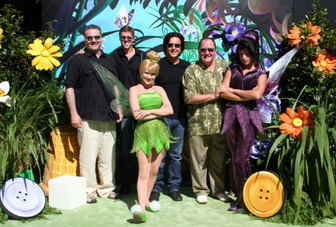
Director Bradley Raymond, writers Rob Muir and Bob Hilgenberg, and Executive Producer
John Lasseter at the premiere of Tinker Bell and the Great Fairy Rescue
AV: Have you written for any of the future Tinker Bell movies?
BH & RM: No.
AV: What are some projects people would be surprised to learn you’ve worked on? Since you were at Disney in the mid-00s, I bet you guys were involved with sequels the public doesn’t even know about.
BH & RM: Not as much as you might think. We’ve worked all over town. We did write a draft of Jungle Book 2 a long time ago, but no big secrets.
AV: What was the story in your Jungle Book 2 draft?
BH & RM: Boy, that was a long time ago. I don’t think we even have a copy of that script, believe it or not. The script-writing program changed through the years, and we never bothered to transfer it over. The story had something to do with a poacher, and Baloo having to save a female bear he had fallen for.
AV: Ultimately, Jungle Book 2 closely resembled its 1967 predecessor, despite having several writers and drafts. Was that one of Disney’s requirements? I mean, how did all of those talented writers ultimately create a sequel that so closely resembled the first film’s storyline?
BH & RM: We have no idea. The script we wrote was a completely different regime. The Jungle Book 2 that was made, to our knowledge, had nothing to do with our work.
AV: What Disney animated films are you currently involved with, in any capacity?
BH & RM: None. However, we are working on a story for an animated feature film that we will be presenting to Disney, soon.
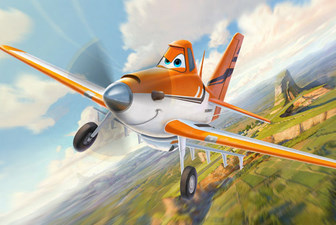
AV: I would love to hear your thoughts on the Cars spin-off, Planes. After all, Circle 7 was closed because Pixar didn’t want Disney doing sequels to its films. Now, six years later, here is Disney pretty much doing a sequel to a Pixar film. That must cause some mixed emotions among the former Circle 7 employees.
BH & RM: We think it’s great! Planes is being produced at DisneyToon Studios, where we worked on Tinker Bell and the Great Fairy Rescue. We got to know the director of Planes, Klay Hall, and found him to be a very talented guy who, while working on his own film, was very helpful on Tinker Bell and the Great Fairy Rescue.
DisneyToon Studios has been one of John Lasseter’s pet projects, and he has put together the same kind of working environment as he has with Pixar. Even recently, DisneyToon Studios moved into a new building which was designed by the same person who designed Pixar. It’s a world-class facility complete with the now-famous cereal bar and – what I would consider – a four-star restaurant run by a well-known chef.
From what we’ve seen of Planes, and know of the crew producing it and the time and research put into the world of Planes, it will be a first-rate film as will the entire Cars slate of films coming out of DisneyToon Studios. John Lasseter pushed everyone hard to deliver on the Tinker Bell franchise, and it surpassed everyone’s expectations. We’re sure Planes will, too.
Can you tell we loved our time at DisneyToon Studios and Tink? Again, it’s teeming with the best talent in the business. Look up some of the names in the credits of the Tinker Bell films, and you’ll find names that worked on some of Disney’s most revered animated films. The Little Mermaid, The Lion King, Aladdin – virtually all of these classics and more are represented by talent in the DisneyToon franchises. And many of these people were with us at Circle 7. So no, there’s no “mixed emotions” at all. Quite the contrary.

An apprehensive Dusty Crophopper prepares for flight in the teaser trailer for DisneyToon’s Planes
AV: You said, “[…]the entire Cars slate of films coming out of DisneyToon Studios.” Allegedly, Planes is the first of three Planes films. I’ve even read solid rumors that DisneyToon Studios could do Boats. But are you suggesting DisneyToon Studios will do Cars films, as in Cars 3?
BH & RM: Well, by “Cars slate,” we meant that the franchise is a part of the Cars family – the look, etc. Yes, we heard that they were developing other films in the franchise, Boats and Trains. But, beyond seeing some visual development, we don’t know what, if any, of the films will be put into production. They may wait to see how well Planes performs.
But, certainly I’ve never heard of a Cars 3 – but would you be surprised? I’m not sure I would. It’s hard to pass up that kind of “free money”! By the way, we love sequels. We’ve always compared them to having a hit TV show. You enjoy seeing the characters in different situations and worlds.
AV: Have you or Brad Raymond had any involvement with Planes? Again, since it’s sort of a sequel to a Pixar film, one would think Circle 7’s former top talent would be placed on the project.
BH & RM: Our only involvement with Planes was simply that we were at DisneyToon Studios while they were breaking the story and creating all of the planes and visual development for the project. We saw some beautiful work and knew they were going to knock the film out of the park. Brad – as with all of DisneyToon Studios, Pixar and Disney Animation Studios – was involved in the way everyone is involved in a creative environment run by John Lasseter. Story reels are screened for other DisneyToon Studios directors and story people, and they are encouraged to offer honest opinions. And yes, as we mentioned, DisneyToon Studios is crawling with former Circle 7 talent!
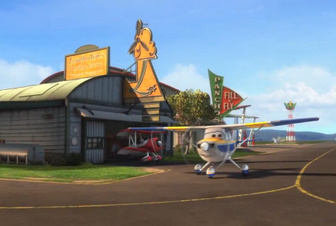
The main setting of Planes, Propwash Junction, is explored in Pixar’s short Air Mater
AV: Last year, you signed two major deals. The first was a live-action Disney film starring Molly Shannon. What can you tell us about it?
BH & RM: Molly is an old friend and used to perform with Rob in The Rob & Molly Show in and around Hollywood. We’re writing this Disney film with her that’s about the social world of motherhood. It has a lot to do with all of our parenting stories and how we’re constantly second-guessing ourselves. Molly is one of the funniest people on the planet. We’re looking forward to getting the script done soon. It’s nice that after Bridesmaids, the industry is recognizing how funny women are!
AV: The other project was a big screen adaptation of The Family Circus. How did that deal happen?
BH & RM: Producer John Baldecchi met with Bil Keane on and off for two years and finally convinced him to let him have the rights. We set it up at Fox and Walden. We get two great studios helping us drive this project to production. It’s just such a rich, relatable, funny world Bil Keane created.
AV: How has the death of Keane affected the project?
BH & RM: It’s inspired us to stay true to what he maintained throughout his 50-plus years writing it.
AV: What is the latest on Meet the Haunteds?
BH & RM: It’s kind of on hold while the director [Steve Carr] works on another film.
AV: You’ve had tremendous success, but you’ve also seen some of your biggest and best projects canceled. With all this experience in mind, what are the greatest lessons you’ve learned?
BH & RM: This is an incredibly difficult business. But if you enjoy what you’re doing and who you’re with, you can survive the blows to the gut a little easier. Just keep your eyes on the prize.
Exclusive Visual Development Artwork!
Woody, Jessie, Slinky, Rex, Hamm and Mr. Potato Head
escape a daycare using a shopping cart and a bubble machine.
Monsters, Inc. 2: Lost in Scaradise
Original Demo Reel


